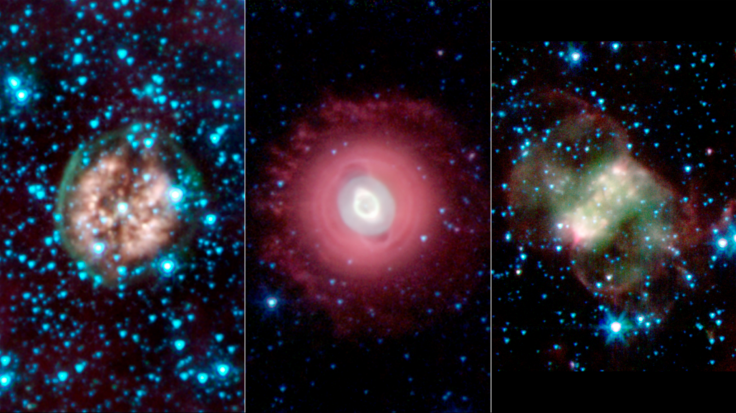NASA Captures Three 'Spooky' Planetary Nebulae, The ‘Ghostly Remains’ Of Dying Stars [PHOTO]
NASA’s Spitzer Space Telescope captured the last remnants of three dying stars. Planetary nebulae are the last breath of stars at the end of their life, but they also play an important role in galactic evolution.

The space agency got into the Halloween spirit and had some fun with the images, nicknaming each one, but the look at dying stars provides plenty of value for researchers. The first image, of the planetary nebula PMR 1, has been dubbed the “Exposed Cranium” nebula; the middle image of NGC 3242 is named the “Ghost of Jupiter”; and the last image of NGC 650 has been coined the “Little Dumbbell.”
Larger stars, with a mass similar to that of our sun, become red giants at the end of their lives, reports NASA. (The term is a misnomer as they have nothing to do with planets.) The stars have already burned through the hydrogen they need for nuclear fusion, switching to helium found in a shell above the carbon-oxygen core. Red giants have an expanded atmosphere, and at the very end of their life they eject an outer layer of gas into space. Researchers can observe this glow via the ultraviolet light from the dying star, which heats up the ejected gas.
The Exposed Cranium nebula is approximately 5,000 light-years from Earth in the Vela constellation. The inner area of the nebula consists of ionized gas while the outer layer contains hydrogen, reports NASA. The Ghost of Jupiter is located 1,400 light-years away in the Hydra constellation and the nebula gets its shape from material that was ejected at different periods, forming the inner rings. The Little Dumbbell nebula is 2,500 light-years from Earth in the Perseus constellation and gets its shape from wind that is blowing ejected material away from the dying star.
Joseph Hora, principal investigation of the Spitzer program from the Harvard-Smithsonian Center for Astrophysics, said planetary nebulae are important in the evolution of the universe as they eject new material into the interstellar medium and researchers can use these images to learn more about the death of stars. Hora said in a statement, “We look to the pictures for a sense of the history of the stars’ mass loss, and to learn how they evolved over time.”
© Copyright IBTimes 2024. All rights reserved.






















